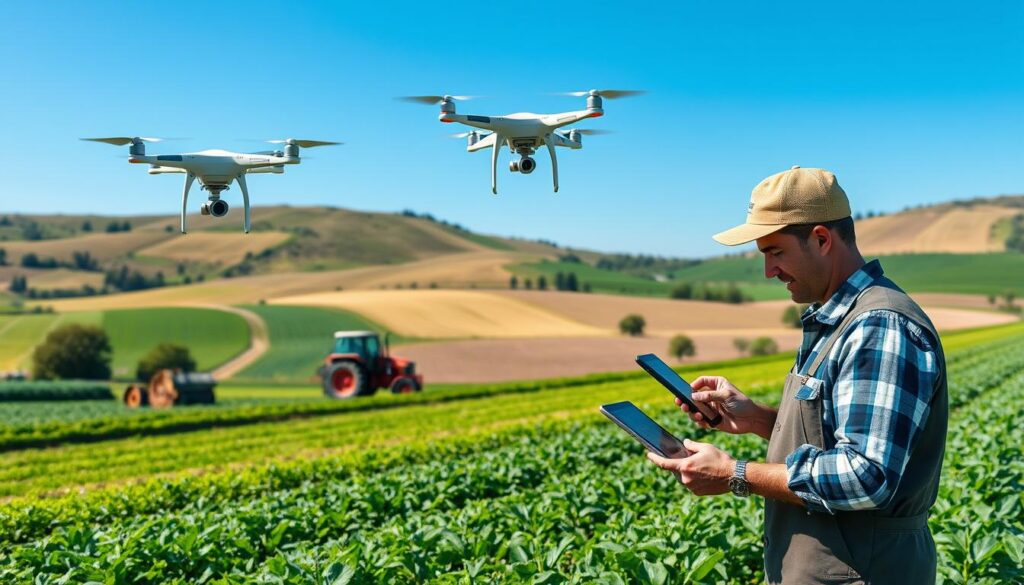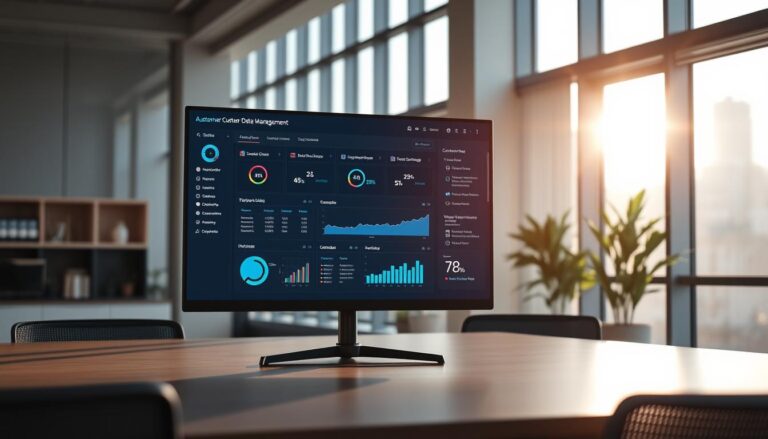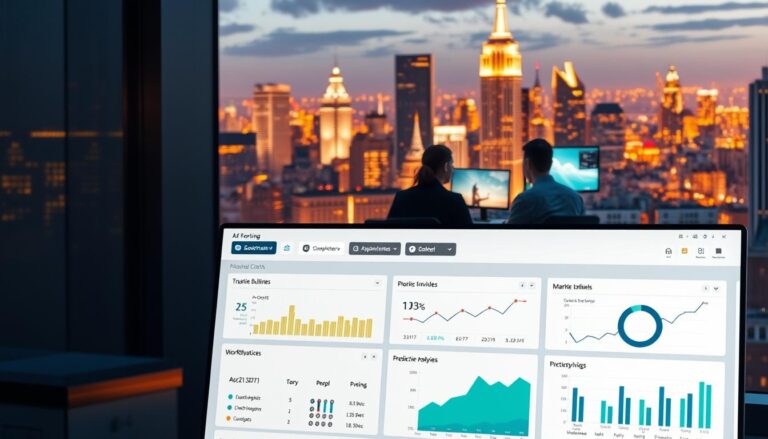Today, the agriculture sector aims for more production and eco-friendly methods. Companies like Intellias are at the forefront, creating new digital tools. These tools help both large agribusinesses and small AgriTech startups. With agtech software development, precision farming and smart tech work together. They transform farming into a high-tech operation, blending tradition with innovation.
Key Takeaways
- Intellias is leading in creating software that makes farming more efficient and sustainable.
- Data analytics and AI are crucial in making smart farming decisions.
- Agtech software gives farmers advanced ways to monitor their crops in real time.
- The global market for agriculture software, now worth over $20 Billion, will keep growing.
- Integrating smart tech like IoT and machine learning improves farming methods and resource use.
- Using automation and analytics in farming software boosts productivity and efficiency greatly.
The Importance of Software Development in Agriculture
The rise of agribusiness software development is changing agriculture for the better. It boosts farming efficiency and productivity with new technology. This leads to better farming operations, improved data management, and a simpler supply chain.
Enhancing Efficiency in Farming Operations
Precision agriculture software plays a key role in today’s farming. It helps farmers do more with less. Technologies like automated tractors and drones make planting and harvesting easier. Software also helps manage resources like water and fertilizer, making farming more sustainable.
Data-Driven Decision Making
Tools in agricultural data analytics give farmers updated info on soil and crops. This info helps them make better choices. By using the cloud, farmers get detailed reports on weather and markets. This helps them plan what to plant next.
Streamlining Supply Chain Management
Software is changing how farm products get from field to table. It makes the supply chain more clear and ensures quality. Managers can now predict demand, manage stocks, and plan delivery better. This cuts waste and boosts efficiency.
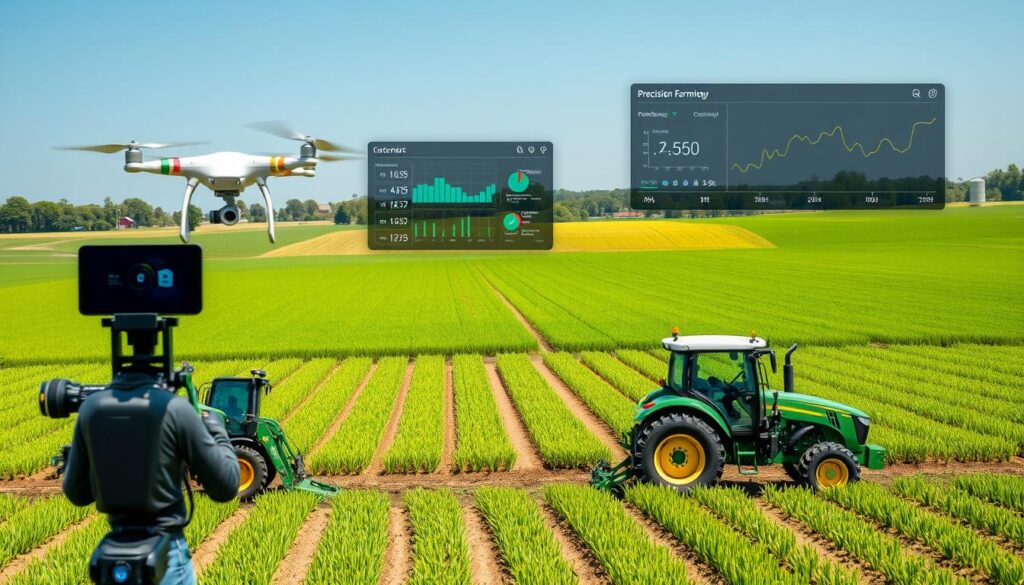
| Management Aspect | Description | Software Example |
|---|---|---|
| Resource Management | Tracks resource usage and predicts future needs | ClimateAi, Trimble Ag Software |
| Financial Planning | Helps in budgeting and financial forecasts | Granular, AgriWebb |
| Crop and Livestock Management | Monitors crop and livestock health for optimal management | FarmLogs, AgriWebb |
| Marketing and Sales | Facilitates market research and sales strategies | FarmLogs, Granular |
Key Software Solutions for Farmers
The world of farming is changing fast, thanks to new software that helps run things smoothly. By 2050, there will be almost 10 billion people on Earth. So, using tech in farming is more important than ever. Farm management software, precision agriculture tools, and agriculture mobile apps are changing the game in farming.
Precision Agriculture Tools
Precision agriculture tools are changing the way we farm. They help farmers use less and produce more. By using GPS, sensors, and data analytics, these tools can check on crops, weather, and the soil. This way of farming is better for the planet and helps grow more food. Check out EOSDA Crop Monitoring software for more on this tech.
Farm Management Systems
Farm management software puts everything in one place to make planning and running a farm easier. ERP systems help with everything from keeping track of supplies to following laws and managing money. They make farms work better and help make smart choices with instant data access. Indeema Software offers top ERP solutions for farms.
Mobile Applications for Crop Monitoring
Agriculture mobile apps have changed how farmers keep an eye on their crops. With these apps, you can see how your crops are doing from anywhere. This means less time checking fields and more time making things better based on what the app tells you. It’s a smart way to boost yields and save resources.
| Feature | Benefits | Example |
|---|---|---|
| Real-time data access | Quick decision-making based on market needs | Agriculture ERP Software |
| Automated compliance | Reduces paperwork, ensures legal adherence | ERP Systems |
| Inventory control | Enables smart purchase decisions, reduces waste | Farm Management Software |
| Resource optimization | Improves utilization of labor and materials | Precision Agriculture Tools |
| Advanced traceability | Ensures food safety from field to consumer | IoT and Data Analytics |
Trends in Agricultural Software Development
The agricultural sector is undergoing significant changes due to AgriTech software development. New technologies help use resources at the right time, make farm operations more efficient, and improve crop management with precision farming. Especially, using Artificial Intelligence (AI) and Internet of Things (IoT) devices is creating important new trends. These advancements save resources and make farm work smoother.
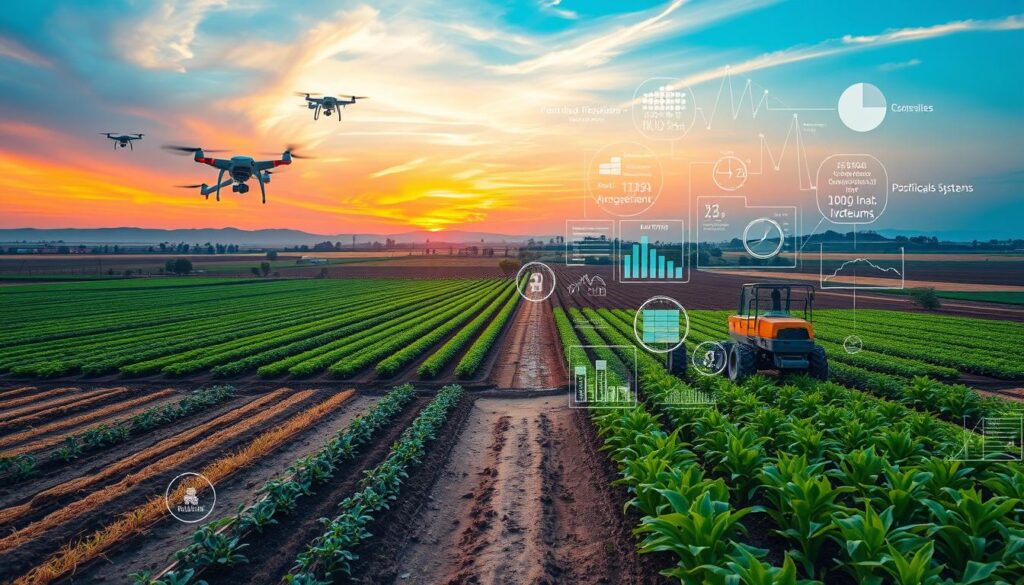
Adoption of Artificial Intelligence
AI use in farming is growing fast. It turns lots of data into useful tips. Farmers use AI to forecast weather, fight pests, and keep tabs on crops. This improves crop amounts and cuts down on waste. A report says the AI in agriculture market will grow from $1.7 billion in 2023 to $4.7 billion by 2028. This shows how vital AI is for sustainability in farming.
Integration of IoT Technologies
IoT use in farming is expected to increase from $13.61 billion in 2022 to $33.57 billion by 2032. This growth shows a big demand for devices that can talk to each other and track things in real-time. These devices make sure water and fertilizers are used precisely. This saves money and reduces the environmental impact of agriculture technology.
Sustainability and Environmental Impact
Moving towards sustainable farming involves using advanced technologies. For example, precision farming that uses IoT and AI helps use farm resources wisely. This cuts down on farming’s environmental effects. It’s important to mix agtech trends the right way. This ensures we get more crops without harming the environment.
Learn more at this informative resource. It goes into detail on how automation and AgriTech innovations are changing farming management and efficiency.
| Technology | Market Value 2023 | Projected Market Value 2028 | Growth Rate |
|---|---|---|---|
| AI in Agriculture | $1.7 billion | $4.7 billion | 23.1% CAGR |
| IoT in Agriculture | $13.61 billion | $33.57 billion | 9.5% CAGR |
| Precision Farming | $9.8 billion | $34.01 billion | 13.30% CAGR |
| Drones in Agriculture | $1.1 billion | $7.19 billion | 20.7% CAGR |
Challenges in Implementing Software Solutions
The path to fully integrated tech in agriculture has bumps along the way. A big hurdle is resistance to technology adoption in agriculture. This often comes from not knowing much about it and fear among traditional farmers. Also, agriculture’s existing systems have complexities adding to agribusiness integration challenges.
Resistance to Technology Adoption
Some farmers are hesitant about digital changes in agriculture. They worry about the costs and think new tech is too complex. Adding things like precision tools and ERP systems to farming is a big shift. It’s not just new technology but a change in culture. It calls for big changes in how people think.
Integration with Existing Systems
A big problem is integrating advanced software with legacy systems. Old barns and methods don’t mix well with new tech. Such tech is often built for modern setups. Successful integration needs strong software and a flexible approach. This approach must fit the varied needs of farms.
Also, there are worries about data security with new tech. More use of sensors and cloud systems brings fears of privacy issues and data leaks. This can slow down tech adoption.
Training and Skill Development for Farmers
It’s key to improve farmer skill development. Farmers must learn to use new systems well, which is tough where tech training is scarce. Also, they need ongoing help to keep up with system updates and fixes.
To understand how to fit ERP systems into agriculture better, look at these comparisons:
| Factor | Challenge | Solution |
|---|---|---|
| Technology Adoption | Strong pushback from traditional farming areas | Custom training and easy-to-use software |
| System Integration | Problems fitting with old setups | ERP systems that integrate step by step |
| Skill Development | Not enough local training | Web platforms and apps for learning anywhere |
Future of Software Development in Agriculture
The agricultural industry is about to change a lot because of new software. This change will help farming last longer and work better. New tools and a growing world population mean we need better farming solutions.
The next big thing in farming technology will use Artificial Intelligence (AI) and the Internet of Things (IoT). This will make farming more advanced than ever before.
Innovations on the Horizon
New farming technologies are not just nice to have. They’re necessary to feed over 10 billion people by 2050. AI is changing how we farm, from watching crops in real-time to predicting the future of farming. And, IoT lets farmers manage things from afar which saves time and hard work.
Examples include drones that spot pests with AI and systems that use sensors to water crops just right. This combination makes farming more effective and earth-friendly.
Collaborations Between Tech and Agri-Experts
When tech experts and farming pros work together, great things happen. Companies like Keenethics are at the front of this movement. They mix AI with IoT to handle farming data well, helping farmers decide what to do next.
The Role of Startups in Agri-Tech Advancement
Startups are leading the charge in changing farming with new tech. The AI in farming is expected to grow a lot, from $1.7 billion in 2023 to $4.7 billion by 2028. Startups find new ways to use AI and IoT in farming.
An example is CattleEye, which uses AI and drones to watch over livestock and boost farming results. Supporting these new ideas and solutions is key to the future of farming technology. It will help make farming more reliable, efficient, and good for the planet.
